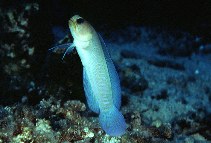| Family: |
Opistognathidae (Jawfishes) |
| Max. size: |
10 cm TL (male/unsexed) |
| Environment: |
reef-associated; marine; depth range 3 - 40 m |
| Distribution: |
Western Central Atlantic: southern Florida, USA and Bahamas to Barbados and northern South America. |
| Diagnosis: |
Dorsal spines (total): 11-11; Dorsal soft rays (total): 15-16; Anal spines: 3-3; Anal soft rays: 14-15. Body light bluish gray with numerous pale blue dots; head, nape and anterior part of dorsal fin yellow; a pair of black spots often present on chin (Ref. 13442). |
| Biology: |
Inhabit burrows made of crushed coral or sand. Hovers vertically, above or near its hole. The male courts the female by swimming in an arched position with his fins spread towards her (Ref. 9710). Male broods the eggs orally (Ref. 5521). Has been reared in captivity (Ref. 35427). |
| IUCN Red List Status: |
Least Concern (LC); Date assessed: 23 January 2012 Ref. (130435)
|
| Threat to humans: |
harmless |
Source and more info: www.fishbase.org. For personal, classroom, and other internal use only. Not for publication.

